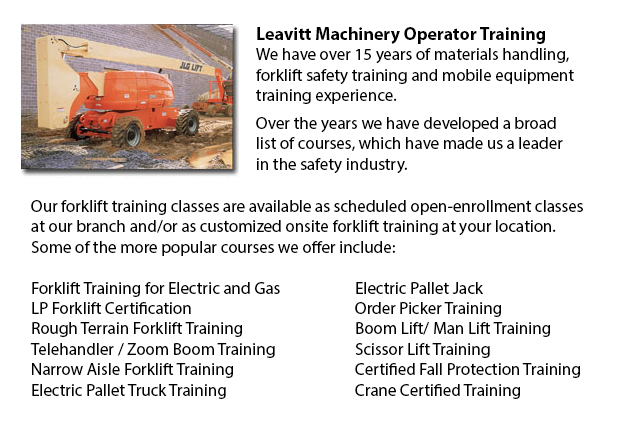
Aerial Lift Safety Training Whitby - Every year, there are approximately 26 construction fatalities attributed to the use of aerial lifts. Nearly all of the craftsmen killed are laborers, electrical workers, carpenters, painters or ironworkers. Most deaths are caused by tip-overs, electrocutions and falls. The greatest danger is from boom-supported lifts, like for example cherry pickers and bucket trucks. Nearly all deaths are related to this kind of lift, with the rest involving scissor lifts. Other dangers consist of being struck by falling things, being thrown out of a bucket, and being caught between the lift bucket or guardrail and an object, like a joist or steel beam.
The safe operation of an aerial lift needs an inspection on the following things prior to utilizing the device: operating and emergency controls, personal fall protection gear, safety devices, and tires and wheels. Check for possible leaks in the air, fuel-system, hydraulic fluid. Inspect the device for loose or missing parts.
The places that worker will use the aerial device should be checked carefully for potential dangers, like holes, bumps, drop-offs and debris. Overhead powerlines have to be avoided and monitored. It is recommended that aerial lift devices be used on stable, level surfaces. Never work on steep slopes which exceed slope restrictions specified by the manufacturer. Even on a level slope, outriggers, brakes and wheel chocks must be set.
Employers are needed to provide aerial lift operators and maintenance mechanics with the right instruction manuals. Operators and mechanics should be trained by a licensed person experienced with the relevant type of aerial lift.
Aerial Lift Safety Tips:
o Prior to operating, close doors and lift platform chains.
o Climbing on and leaning over guardrails is prohibited. Stand on the floor of the bucket or platform.
o Stay within manufacturer's load-capacity limitations.
o Use work-zone warnings, like for instance cones and signs, when working near traffic.
If proper procedures are followed, electrocutions are preventable. Stay at least 10 feet away from whatever power lines and licensed electricians must de-energize and/or insulate power lines. Those working have to utilize personal protective tools and equipment, like for instance insulated bucket. Then again, a bucket that is insulated does not protect from electrocution if, for example, the worker touches a different wire providing a path to the ground.
Falls are preventable if the worker remains secure in guardrails or within the bucket by utilizing a full-body harness or a positioning device. If there is an anchorage inside the bucket, a positioning belt along with a short lanyard is acceptable.
Tip-overs are preventable by following the manufacturer's instructions. Unless otherwise specified by the manufacturer, never drive whilst the lift platform is elevated. Follow the horizontal and vertical reach limitations of the device, and never go beyond the load-capacity that is specified.
-
Wheel Loader Operator Training Whitby
Wheel Loader Operator Training Whitby - To be able to lift considerable loads, industrial cranes use levers and pulleys. In the past, Roman people used cranes to be able to erect large monuments making the origin of these equipment at least two thous... More -
Aerial Lift / Boom Lift / Man Lift / Scissor Lift Training in Whitby
Scissor lifts are lift truck tables which lift up materials and people and supplies vertically. They are normally utilized in commercial, industrial and construction environments. A common use of scissor lifts is for lifting or lowering construction... More -
Manlift Operator Training Whitby
Manlift Operator Training Whitby - A specialized kind of hydraulic platform is called an aerial lift or a man lift. It is intended to lift an individual vertically up and down and thus, is likewise known as a vertical personnel lift. This machinery i... More -
Aerial Lift Ticket Whitby
Aerial Lift Ticket Whitby - A boom truck is frequently recognized by the cable and telephone business vans that have the extended arm folded over their roofs. Commonly, a bucket-like apparatus sits at the extension of extendable arms. Often known as... More -
Crane Training Whitby
Crane Training Whitby - Overhead cranes are otherwise known as bridge cranes. They are a kind of crane which has a line and hook mechanism which runs along a horizontal beam which runs along two widely separated rails. Numerous overhead cranes could... More -
Forklift Certification Schools Whitby
Forklift Certification Schools Whitby - Within North America, forklift certification is mandatory, making forklift training programs essential for both the company and their employees working as operators of forklifts. Forklift training focuses on he... More -
Crane Safety Training Whitby
Crane Safety Training Whitby - Companies and crane drivers need to be aware of the issues connected to crane safety. Legislation provides rules for the safe operation, inspection and maintenance of lifting machinery all around North America. Crane Sa... More -
Overhead Crane Certification Whitby
Overhead Crane Certification Whitby - The overhead crane certification course is a course that is designed to assist trainees, even if they have literacy or language restrictions. The program consists of a classroom theory part and a practical hands-... More

Forklift Training Whitby
TOLL FREE: 1-888-254-6157
Whitby, Ontario
forklifttrainingwhitby.com
Email Us
About Us


